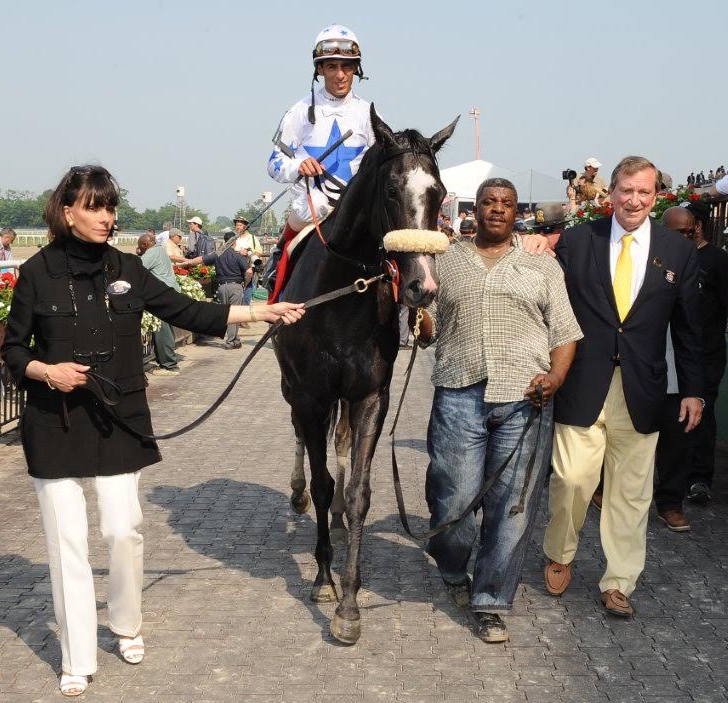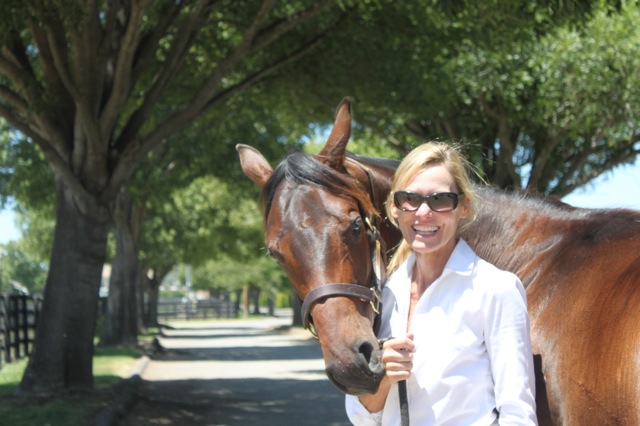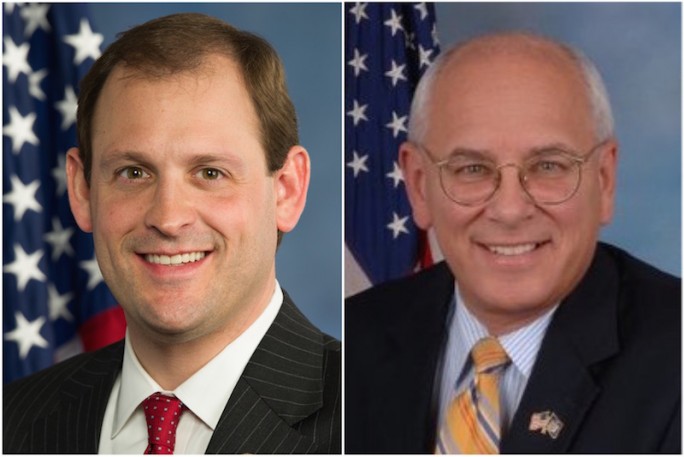
Mrs. Ellen Charles, owner of Hillwood Stables LLC, presenting the trophy to Rachael Lively and Bet A Quarter winners of the $7,500 Hillwood Stable Jumper Speed Stake (3’7”).
Photo: MJC/Rough Coat Photography
A record number of donors—including Triple Crown winner American Pharoah’s Zayat Stables— stepped up this year to support the 4th annual Totally Thoroughbred Show at Pimlico Race Course; and in a big way!
Because of generous support from the pinnacle of racing, including Stonestreet Stables, which donated proceeds from its 2015 Black-Eyed Susan win, the horse show for ex-racehorse Thoroughbreds was an affair that brought out the best in everyone, says horse show manager Phoebe Hayes.
“Because of the generosity of our sponsors, we were able to bump up our purse money and we had one of our best years ever,” says Hayes, who notes that the Totally Thoroughbred Show is especially grateful to Ellen Charles of Hillwood Stable LLC for making the Jumper Speed Stake so exciting and rewarding this year.
Thanks to heavy sponsorship, the Totally Thoroughbred Show was able to distribute $17,000 in prize money and donate $9,624 to two OTTB charities, Hayes says. The charities are MidAtlantic Horse Rescue, operated by Beverly Strauss, and the Foxie G Foundation.

Pimlico Perpetual trophy presented in memory of Wiseman’s Ferry by Dana Point Farm and Wiseman’s Ferry Syndicate. Trophy presentation to My Name’s Shane, owner/rider Jennifer Campbell. Presentation by TTHS judge Wendy Davis and TTHS founder, MJC Vice President Racing, Georganne Hale.
Photo: Equiery/Linda Davis
“I think the most exciting aspect to this year’s show was the incredible support we had from sponsors,” says Hayes, who took over the reins from Hale in the management of the show this year. “Zayat Stables and Stonestreet Farms are both new sponsors for us this year, and I hope they help start a trend.”
As the popularity of the Pimlico show grows every year since its founding by Maryland Jockey Club Racing Secretary Georganne Hale, the goal is to go even bigger next year. “We hope to have even more classes and more prize money next year,” Hayes adds.
This year’s top prizes went to ex-racehorse Thoroughbred Bet A Quarter, who with rider Rachel Lively won the Hillwood Stable LLC Jumper Speed Stakes, taking home $7,500 in purse money and to My Name’s Shane and owner/rider Jennifer Campbell, who won the Pimlico Perpetual Trophy; an award given in honor of Wiseman’s Ferry, sire of Wise Dan. The trophy is awarded to the team earning the greatest total points, Hayes says, noting that if this year’s winners come back and win it two more times, the trophy will be engraved and retired with their names on it.
The Totally Pimlico Show drew approximately 152 Thoroughbreds who competed in over 300 classes, says Hayes, noting that the show helps to kick off the Thoroughbred Alliance Show Series, and 19 shows throughout the Mid-Atlantic region.
Hayes adds that the show would not have been possible without tremendous support from a long list of sponsors, including the Jockey Club, and an army of volunteers, as well as judges Wendy Davis, Rodney Jenkins and Steuart Pittman. She notes that the course was designed by Tim Tullock, a Maryland-based trainer and accomplished show jumper.
At the end of the day, after the last jump was cleared, and the last ribbon awarded, Hayes sized up the show as a powerful force for good: Riders and OTTBs were able to compete for prize money donated by the Thoroughbred racing industry, while demonstrating the inherent worth of the Thoroughbred sport horse.






